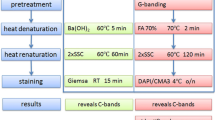Summary
A number of acidic dyes, including various fluorochromes, were substituted for biebrich scarlet in the modified Guard (1959) procedure, a regressive staining method which appears to demonstrate basic chromosomal proteins. These substitutions were made to test the possibility that dyes other than biebrich scarlet might provide advantages in sensitivity and/or contrast, or that more control could be exerted over the “differentiation” step in which solutions of phosphotungstic and phosphomolybdic acids (polyacids) are used.
Of the dyes tested in this investigation, six were found to be especially suitable: procion brilliant blue, procion yellow, geranine G, brilliant sulfoflavine, eosin Y, and eosin B. While procion brilliant blue could be used as an absorption dye only, the other dyes were used more profitably as fluorochromes. The various dyes displayed considerable variability in the ease with which they could be displayed from substrates with polyacid solutions during the differentiation step. Procion brilliant blue, procion yellow, and geranine G were displaced gradually and thus resembled biebrich scarlet. In contrast, eosin B, eosin Y, and brilliant sulfoflavine were displaced more easily from all but the most highly condensed chromatin in substrates. Brilliant sulfoflavine yielded exceptionally bright and nearly selective fluorescence of consensed chromosomes in division, “X” chromosomes of grasshopper spermatocytes, and sperm heads.
Weak, but selective fluorescence was observed when monazo sulfonated dyes, including ponta chrome violet SW, eriochrome black, diamond red, and ponta chrome blue black, were substituted in the modified Guard procedure. Similar results were obtained with solochrome cyanin R. As expected, these dyes seemed to function as weakly acidic dyes.
Similar content being viewed by others
References
Bennion, P.J., Horobin, R.W.: Some effects of salts on staining: Use of the Donnan Equilibrium to describe staining of tissue sections with acid and basic dyes. Histochemistry 39, 71–82 (1974)
Cowden, R.R.: Mikrospectrophotometrische Untersuchungen an der interphasischen chromosomalen Nucleoprotein-Struktur. Verh. dtsch. zool. Ges., 130–134 (1975)
Cowden, R.R., Rasch, E.M., Curtis, S.K.: Cytochemical evaluation of the Guard procedure, a regressive staining method for demonstrating chromosomal basic proteins. I. Effects of fixation, blocking reations, selective extractions, and polyacid “differentiation”. Histochemistry (1976)
Deitch, A.D.: Microspectrophotometric study of the binding of the anionic dye, naphthol yellow S by tissue sections and by purified proteins. Lab. Invest. 4, 324–351 (1955)
Flint, M.H., Lyons, M.F.: The effect of heating and denaturation on the staining of collagen by the Masson trichrome procedure. Histochem. J. 7, 547–555 (1975)
Flint, M.H., Lyons, M.F., Meaney, M.F., Williams, D.E.: The Masson staining of collagen — an explanation of an apparent paradox. Histochem. J. 7, 529–546 (1975)
Guard, H.R.: A new technique for differential staining of the sex chromatin, and the determination of its incidence in exfoliated vaginal epithelial cells. Amer. J. clin. Path. 32, 145–151 (1959)
Hall, C.T., Hansen, P.A.: Chelated azo dyes used as counterstains in the fluorescent antibody technic. Zbl. Bakt. I. Abt. Orig. 184, 548–554 (1962)
Horobin, R.W., Goldstein, D.J.: The influence of salt on the staining of tissue sections with basic dyes: An investigation into the general applicability of the critical electrolyte concentration theory. Histochem. J. 6, 599–609 (1974)
Ringertz, N.R.: Cytochemical properties of nuclear proteins and deoxyribonucleoprotein complexes in relation to nuclear function. In: Handbook of molecular cytology (A. Lima-De-Faria, ed.), pp. 656–684. New York: American Elsevier Publ. Co. 1969
Scott, J.E., Dorling, J.: Differential staining of acid glycosaminoglycans (mucopolysaccharides) by Alcian Blue in salt solutions. Histochemie 5, 221–233 (1965)
Stead, C.V.: The chemistry of reactive dyes and its releavance to intracellular staining techniques. In: Intracellular staining in neurobiology (S.B. Kater and C. Nicholson, eds.), pp. 41–59 Berlin-Heidelberg-New York: Springer 1973
Author information
Authors and Affiliations
Rights and permissions
About this article
Cite this article
Cowden, R.R., Curtis, S.K. Cytochemical characterization of the modified Guard procedure a regressive staining method for demonstrating chromosomal basic proteins. Histochemistry 48, 93–100 (1976). https://doi.org/10.1007/BF00494547
Received:
Issue Date:
DOI: https://doi.org/10.1007/BF00494547




